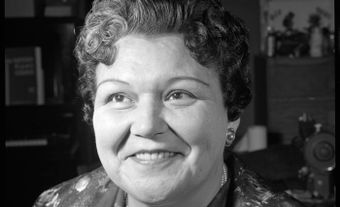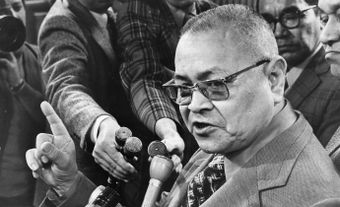The Guerin case (R. v. Guerin) resulted in a pivotal decision by the Supreme Court of Canada in 1984 about Indigenous rights. It centred on the fiduciary (guardian or trustee) responsibility of the Crown to consult openly and honestly with Indigenous peoples before making arrangements for the use of their land. (See also Duty to Consult.) For the first time, it established that the Crown has a legal responsibility to First Nations and not simply a moral one. It also recognized Aboriginal title to their land to be a sui generis (Latin for “unique”) right.
Background
The Musqueam First Nation held about 169 hectares of valuable land overlooking the mouth of the Fraser River in the prestigious Vancouver, British Columbia, neighbourhood of Southlands. In 1956, the exclusive Shaughnessy Heights Golf Club (now Shaughnessy Golf and Country Club) was looking for a site to build a new golf course as their lease would expire in 1960. Club officials approached the Indian Affairs Branch of the federal government in the hopes of leasing some 66 hectares of the First Nation’s land. At the same time, a Vancouver property developer had expressed interest in a long-term lease for the land, but this was never communicated to the Musqueam.
During discussions with Musqueam members, Indian Affairs assured them that they would receive revenue from the 75-year lease, which would be adjusted every decade to reflect fair market rates. As a result, the Musqueam surrendered the 66 hectares to the Crown. The Crown then leased that land to the golf club in October 1957 for $29,000 per year, on behalf of the Musqueam First Nation. This agreement was based on certain oral and written terms. Once Indian Affairs received the consent of the Musqueam however, its representatives then renegotiated the rent with the club under very favourable conditions for the club, which did not include the oral agreement.
The new terms of the lease also specified renewal periods of 15 years rather than 10, as well as a maximum rent increase of 15 per cent for the second 15-year term. Indian Affairs did not provide the Musqueam with a copy of the lease and these facts were kept from them. Then, in 1970, Chief Delbert Guerin was granted access to Indian Affairs archives and became the first Musqueam individual to see the actual terms of the lease. It took five more years before the Musqueam were able to find a lawyer who would take their case. This was due to the lack of legal or government recognition of Indigenous rights and title at that time.
Did You Know?
Chief Delbert Guerin’s mother, Gertrude Guerin, was also named as an appellant in the case. Elected chief in 1959, Gertrude was a strong Musqueam leader and defender of Indigenous rights and culture.
Court Cases
In 1975, the case was initially filed in the Federal Court Trial Division. The judge found the Crown in breach of trust as the trustee for the Musqueam. It had executed the lease on different and less favourable terms than originally discussed and without the First Nation’s consent. The judge assessed the Musqueam’s damages at $10 million, based on his evaluation of their actual loss at the time of the trial.
The Crown appealed this decision to the Federal Court of Appeal, which overturned the judgment of the Trial Division and dismissed the Musqueam’s action. The judge’s ruling was based on a provision of the Indian Act, which he interpreted to mean that the government had complete discretion to decide how the Musqueam First Nation’s land could be used. He also ruled the government was not liable for any failure to adhere to the oral terms of the lease.
The Musqueam’s case was appealed to the Supreme Court of Canada and, on 1 November 1984, it released its decision. Eight of the nine Supreme Court justices participated in the judgment, which consists of three opinions. Although none of the opinions had the support of a majority of the justices (five or more), the justices clearly agreed that the Crown has a general fiduciary duty toward First Nations’ lands, which is enforceable by the courts. Despite any differences in interpretation between the justices, they unanimously agreed to reverse the decision of the Federal Court of Appeal.
Basis for Supreme Court Decision
A First Nation is prohibited from transferring its lands directly to a third party. Any sale or lease can only take place after a surrender of the land occurs, with the Crown acting on behalf of the First Nation. The Crown assumed this responsibility with the Royal Proclamation of 1763, and it is still recognized in the surrender provisions of the Indian Act. It is the surrender requirement and the responsibility it entails that are the source of the Crown’s fiduciary obligations to First Nations. This obligation also requires the Crown to protect the interests of First Nations in transactions with third parties.
The justices also noted that Aboriginal title predated the Royal Proclamation as a legal right, based on First Nations’ historic occupation and possession of the land. This means that Aboriginal title exists independently of the Royal Proclamation and does not depend on treaty, executive order or legislation. The idea that Aboriginal title stems from historical occupation of their lands also conforms to two early and influential cases of the Supreme Court of the United States, Johnson v. Mclntosh (1823) and Worcester v. Georgia (1832).
Long-Term Impact
The Supreme Court decision in the Guerin case is one of the most important legal judgments in the history of Indigenous law in Canada. It recognized two key principles:
1. The Crown has a fiduciary duty toward First Nations and their lands, which can be enforced through the courts.
2. It reaffirmed the existence of Aboriginal title to First Nations lands.
The concept of “fiduciary duty” has become an important element in other Indigenous rights cases. It also became integral in the interpretation of Section 35 of the Constitution Act, 1982, which provides for the protection of Indigenous rights.
Commemoration
The Musqueam First Nation recognizes 1 November every year as Musqueam Day. This holiday celebrates and honours the Supreme Court decision.

 Share on Facebook
Share on Facebook Share on X
Share on X Share by Email
Share by Email Share on Google Classroom
Share on Google Classroom








